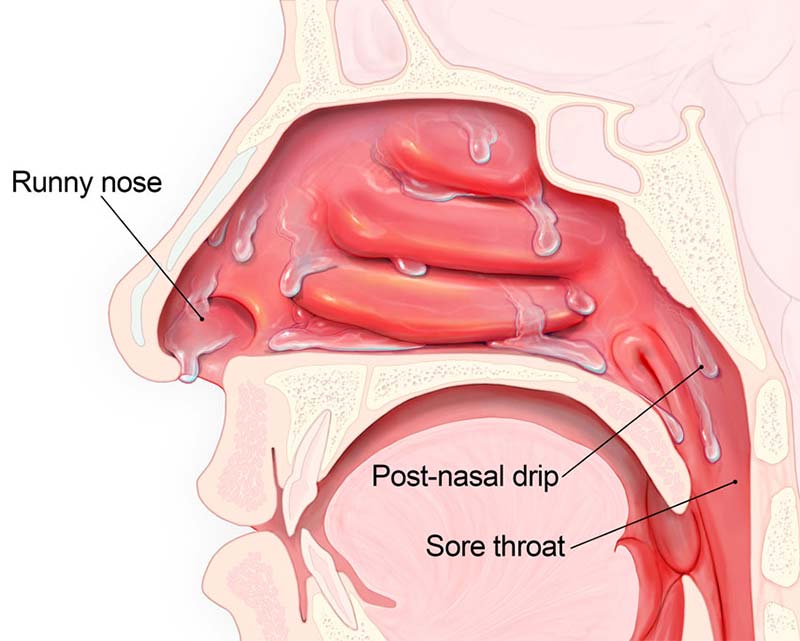The nose, throat, and sinuses are all constantly producing mucus. Postnasal drip is extra mucus felt in the back of the nose and throat caused by glands in the sinus.
Information courtesy of American Academy of Otolaryngology-Head and Neck Surgery
Glands in your nose and throat continually produce mucus (one to two quarts a day). Mucus moistens and cleans the nasal membranes, humidifies air, traps and clears inhaled foreign matter, and fights infection. Although it is normally swallowed unconsciously, the feeling of it accumulating in the throat or dripping from the back of your nose is called post-nasal drip. This sensation can be caused by excessively thick secretions or by throat muscle and swallowing disorders.
Increased thin clear secretions can be due to colds and flu, allergies, cold temperatures, bright lights, certain foods/spices, pregnancy, and other hormonal changes. Various drugs (including birth control pills and high blood pressure medications) and structural abnormalities can also produce increased secretions. These abnormalities might include a deviated or irregular nasal septum (the cartilage and bony dividing wall that separates the two nostrils).
Increased thick secretions in the winter often result from dryness in heated buildings and homes. They can also result from sinus or nose infections and allergies, especially to foods such as dairy products. If thin secretions become thick, and turn green or yellow, it is likely that a bacterial sinus infection is developing. In children, thick secretions from one side of the nose can mean that something is stuck in the nose such as a bean, wadded paper, or piece of toy. If these symptoms are observed, seek a physician for examination.
Swallowing problems may result in accumulation of solids or liquids in the throat that may complicate or feel like post-nasal drip. When the nerves and muscles in the mouth, throat, and food passage (esophagus) aren?t interacting properly, overflow secretions can spill into the voice box (larynx) and breathing passages (trachea and bronchi), causing hoarseness, throat clearing, or coughing.
Swallowing problems may also be caused by gastroesophageal reflux disease (GERD). This is a backup of stomach contents and acid into the esophagus or throat. Heartburn, indigestion, and sore throat are common symptoms. GERD may be aggravated by lying down, especially following eating. Hiatal hernia, a pouch-like tissue mass where the esophagus meets the stomach, often contributes to the reflux.
Post-nasal drip often leads to a sore, irritated throat. Although there is usually no infection, the tonsils and other tissues in the throat may swell. This can cause discomfort or a feeling that there is a lump in the throat. Successful treatment of the post-nasal drip will usually clear up these throat symptoms.
A correct diagnosis requires a detailed ear, nose, and throat exam, and possibly laboratory, endoscopic (procedures that use a tube to look inside the body), and x-ray studies. Treatment varies according to the following causes:
General measures that allow mucus secretions to pass more easily may be recommended when it is not possible to determine the cause. Many people, especially older persons, need more fluids to thin out secretions. Drinking more water, eliminating caffeine, and avoiding diuretics (medications that increase urination) will help. Mucous-thinning agents such as guaifenesin (Humibid®, Robitussin®) may also thin secretions. Nasal irrigations may alleviate thickened secretions. These can be performed two to four times a day either with a nasal douche device or a Water Pik® with a nasal irrigation nozzle. Warm water with baking soda or salt (½ to 1 tsp. to the pint) or Alkalol®, a nonprescription irrigating solution (full strength or diluted by half warm water), may be helpful. Finally, use of simple saline (salt) nonprescription nasal sprays (e.g., Ocean®, Ayr®, or Nasal®) to moisten the nose is often very beneficial.
Sinuses are air-filled cavities in the skull. They drain into the nose through small openings. Blockages in the openings from swelling due to colds, flu, or allergies may lead to acute sinus infection. A viral cold that persists for 10 days or more may have become a bacterial sinus infection. This infection may increase post-nasal drip. If you suspect that you have a sinus infection, you should see your physician to see if it needs antibiotic treatment.
Chronic sinusitis occurs when sinus blockages persist, causing the lining of the sinuses to swell further. Polyps (growths in the nose) may develop with chronic sinusitis. Patients with polyps tend to have irritating, persistent post-nasal drip. Evaluation by an otolaryngologist may include an exam of the interior of the nose with a fiberoptic scope and CAT scan x-rays. If medication does not relieve the problem, surgery may be recommended.
Vasomotor Rhinitis describes a nonallergic "hyperirritable nose" that feels congested, blocked, or wet.
